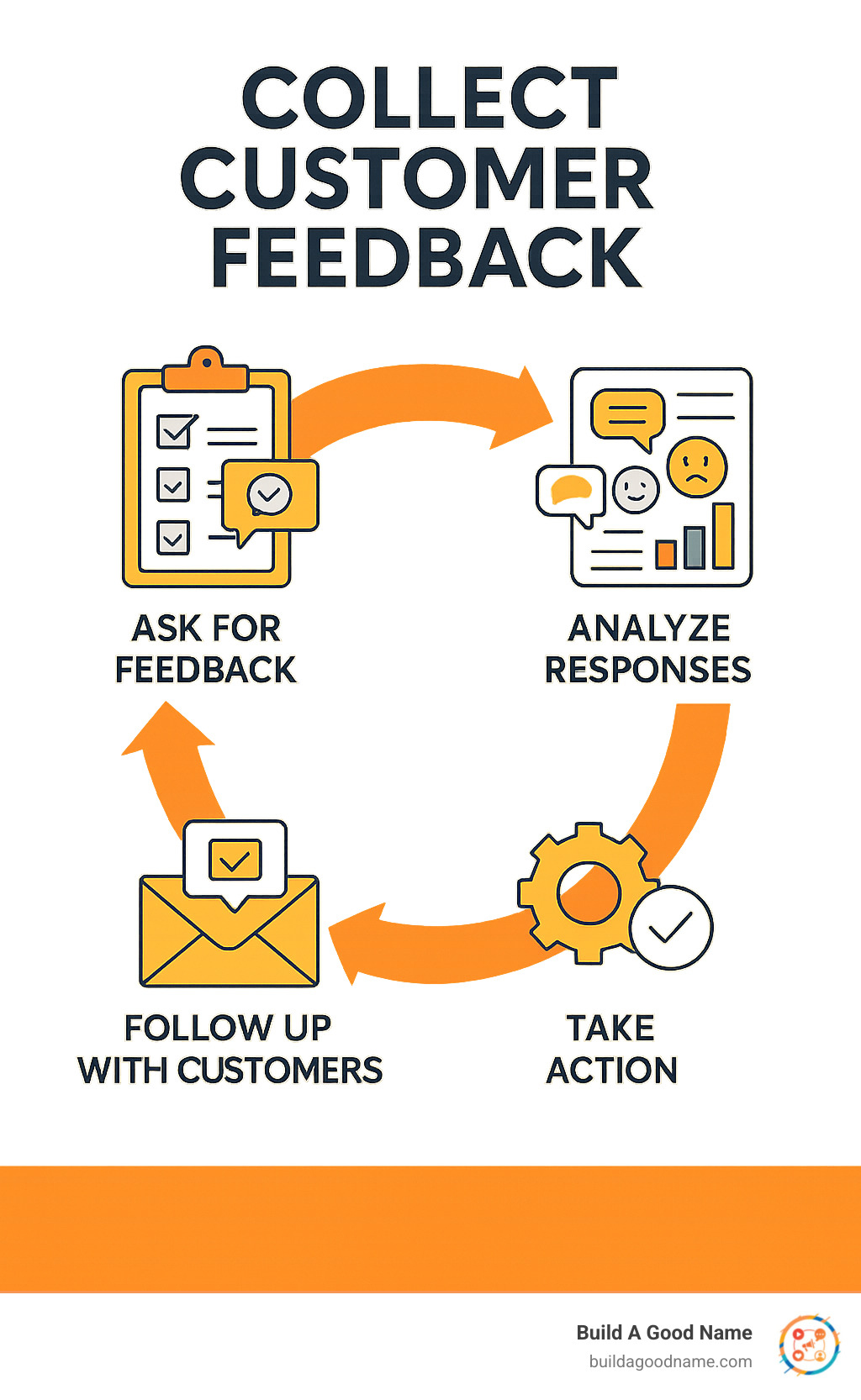Why Customer Feedback is the Foundation of Business Success
Learning how to collect customer feedback effectively is one of the most powerful ways to grow your business. Customer feedback is information customers share about their experiences with your products, services, or brand – and it’s the secret weapon that separates thriving businesses from struggling ones.
Most effective ways to collect customer feedback:
- Customer surveys (NPS, CSAT, CES scores)
- Online reviews and third-party platforms
- Website feedback widgets and forms
- Social media listening and monitoring
- Customer interviews and focus groups
- Usability testing and A/B testing
- Transactional emails after purchases
- Point-of-sale feedback collection
- Support ticket analysis and chat logs
- Product usage analytics and behavior data
Here’s the reality: only 1 in 26 unhappy customers will actually tell you they’re unhappy. The rest just disappear without a trace. That’s why you need a smart system to capture feedback before problems spiral out of control.
Netflix learned this lesson when they changed their rating system from 5 stars to thumbs up/down. That simple change increased customer engagement by 200%. Why? Because they made it easier for customers to share their thoughts.
Research shows that customers are two and a half times more likely to make additional purchases after a 5-star experience. But here’s the kicker – 77% of customers view brands more favorably when businesses actively ask for and use their feedback.
For busy local business owners, collecting feedback doesn’t have to be overwhelming. The key is choosing the right methods for your business and automating what you can.

Why Customer Feedback is Your Business’s Superpower
Customer feedback is the clearest roadmap to growth you will ever get. When you deliberately collect customer feedback, you learn directly from the people who pay your bills.
Your shoppers spot every tiny friction point—confusing checkouts, slow shipping, standout service moments. They’re basically a team of consultants who want you to win.
The impact is measurable. Customers are two and a half times more likelier to buy again after a 5-star experience than after a 1-2-star one. That drives customer retention, lowers acquisition costs, and fuels steady growth.
Because feedback replaces guesswork with facts, it powers smarter product development, sharper market research, and a stronger brand reputation—all without costly ad spend. Even better, it functions as an early-warning system; every comment is a chance to spot pain points before they snowball.
For local companies, Customer Feedback Management is a secret weapon. Quick tweaks based on a single review show customers you’re listening, turning them into vocal advocates.
Over time, feedback creates a loyalty loop: great experiences lead to glowing reviews, which attract new buyers, whose input sparks further improvements. Ask, listen, act—then watch loyalty compound.
10 Proven Methods to Collect Customer Feedback

Feedback arrives in three flavors:
- Active – you ask for it (e.g., surveys).
- Passive – customers volunteer it (e.g., reviews).
- Indirect – you infer it from behavior (e.g., analytics).
Blend all three for the clearest picture. Here are the ten tactics our clients rely on most.
1. Customer Surveys (NPS, CSAT, CES)
Keep surveys short and timely. One-to-three questions sent right after a purchase or support interaction drives completion rates over 80 %. Tools like Customer Review Automation can schedule and send them for you.
2. Online Reviews and Third-Party Sites
Reviews double as always-on focus groups and powerful social proof. Prompt happy customers for a Google review as soon as the positive moment happens. Google Review Generation can automate the ask, and you can amplify wins by Sharing Google Reviews on Social Media.
3. Website Feedback Widgets and Forms
A small button or exit-intent popup lets visitors speak up while context is fresh. Keep forms lightweight—one open text box or a quick star rating—to capture in-the-moment insights.
4. Social Media Listening
Set alerts for brand mentions and relevant hashtags; reply quickly—40 % of users expect an answer within an hour. Polls and story stickers give you rapid-fire opinions with almost zero friction.
5. Customer Interviews and Focus Groups
A handful of 15-minute calls often reveal insights you’ll never see in data. Record (with permission), ask open questions, and listen more than you talk.
6. Usability Testing
Watching customers use your product uncovers friction they can’t put into words. Simple A/B tests or task-completion studies can deliver conversion-boosting tweaks (Netflix’s switch to thumbs up/down increased engagement by 200 %).
7. Transactional Emails
With 80 %+ open rates, receipts and shipping notifications are ideal for a one-question survey. Tie the question to the peak-end rule: “How was checkout today?” or “Did your order arrive as expected?” Automated Review Replies closes the loop at scale.
8. Point-of-Sale (POS) Feedback
Teach staff to ask, “How was everything?” and add a QR code on the receipt for anyone who prefers digital. Tablet kiosks near the exit can capture a thumbs-up/down in seconds.
9. Support Tickets and Chat Logs
Tag and categorize recurring issues. A pattern that shows up in support is usually worth a fix. Simple happiness ratings help you measure service quality while you learn.
10. Product and Usage Analytics
Actions speak louder than words. Funnel reports, feature adoption, and churn indicators expose what customers love, ignore, or find frustrating. Our Free Online Review Monitoring Tool complements these numbers with sentiment trends.
From Data to Decisions: How to Analyze and Use Feedback

Collecting feedback is step one; turning it into change is where the payoff lives.
Categorize and Quantify Your Findings
Group comments into simple buckets—product, service, price, usability, communication. Use basic sentiment analysis or manual tagging to spot patterns. Prioritize by how often and how severely an issue appears.
Turn Insights into an Action Plan
Convert themes into tasks with owners and deadlines. Quick wins like bug fixes or clearer copy often deliver outsized lifts. Larger feature requests should feed your roadmap, backed by the volume of demand. If you’re flooded with comments, AI for Business Reviews can surface the most actionable ones.
Close the Loop with Your Customers
Let people know you heard them. Acknowledge suggestions, announce improvements, and thank contributors. This visible follow-through encourages more input and deepens loyalty. For public reviews, see our tips on Best Responses to Google Reviews.
5 Best Practices for an Effective Feedback Strategy

After working with thousands of local businesses, we’ve distilled feedback success into five habits.
1. Make It Effortless
One-click ratings, short forms, and mobile-friendly layouts respect your customer’s time.
2. Ask at the Right Moment
Trigger requests immediately after the relevant experience—not during it—so memories are fresh and positive.
3. Offer Thoughtful Incentives
A small discount or contest entry can double response rates, as long as it doesn’t depend on a positive rating.
4. Personalize Every Ask
Use the customer’s name and reference their exact purchase or visit. Relevance beats volume.
5. Act and Show Your Work
Publish “You asked, we delivered” updates, thank contributors directly, and focus on constructive insights with tools that Filter Negative Reviews.
Conclusion: Turn Feedback into Your Greatest Asset
Learning how to collect customer feedback effectively isn’t just a nice-to-have skill – it’s absolutely essential for any business that wants to thrive in today’s competitive marketplace. The ten methods we’ve explored give you a complete roadmap for understanding what your customers really think and need.
Here’s the thing: you don’t need to implement every single method tomorrow. That’s a recipe for overwhelm and burnout. Instead, start with one or two approaches that feel natural for your business. Maybe begin with simple post-purchase surveys and Google review requests, then gradually add social media listening and website feedback widgets as you get comfortable.
The businesses that truly succeed are those that create a continuous feedback culture. They don’t just collect opinions and file them away – they turn insights into action, communicate changes back to customers, and use feedback to build deeper relationships. It becomes part of their DNA, not just another task on the to-do list.
For local businesses, this approach can be your secret weapon. While big corporations get bogged down in red tape and slow decision-making, you can pivot quickly based on customer input. You can provide the personalized, responsive service that builds the kind of loyalty money can’t buy.
The beauty of feedback is that it creates a virtuous cycle. When customers see you listening and making real changes based on their suggestions, they feel valued. They become advocates who recommend you to friends and family. They stick around longer and spend more money.
If you’re ready to streamline your feedback collection process, consider using dedicated Review Management Software designed specifically for local businesses. Our platform at Build A Good Name takes the heavy lifting out of collecting, managing, and showcasing customer feedback. It automates the time-consuming parts while letting you focus on what matters most – acting on insights to improve your business.
The companies that will dominate tomorrow’s marketplace are those that master the art of listening today. Your customers are already talking about their experiences – the question is whether you’re hearing them. Start implementing these feedback collection methods now, and watch as customer insights transform your business from ordinary to extraordinary.
Ready to take the next step? Learn more about review management for local businesses and find how the right tools can make feedback collection effortless while boosting customer satisfaction and your online reputation.



